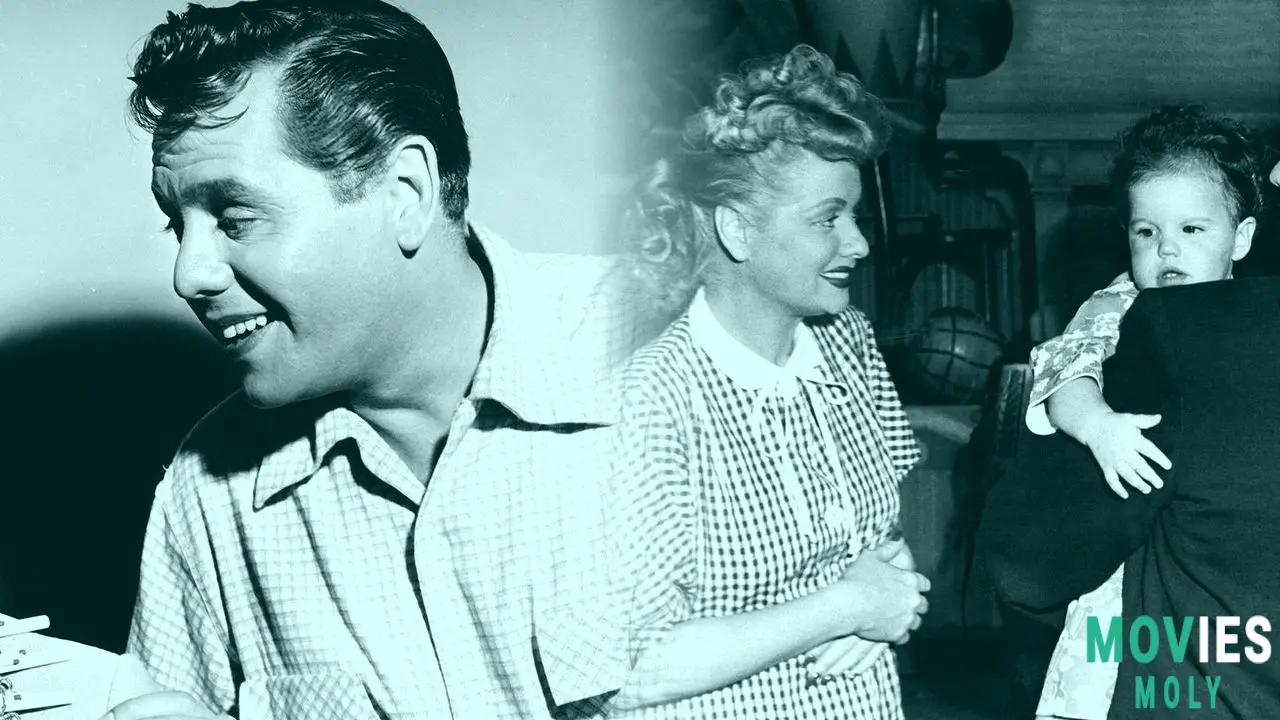When you think about Desi Arnaz, you probably think straight to Ricky Ricardo, singing "Babalú" and telling Lucy she had some'splainin' to do. He was unquestionably that guy: the irritated but devoted husband of Lucille Ball, one of the greatest comedians of the twentieth century. But, truthfully, he was much more than that. It's astonishing how much he influenced early television, making him someone who needs more attention.
Todd S. Purdum's latest book, "Desi Arnaz: The Man Who Invented Television," makes a big claim in its title. You could wonder, "Who invented television?" Really?" Well, when you think about what he did with "I Love Lucy," it all makes sense. The show was a trailblazer in many respects. It featured a three-camera system with a live audience, as do modern sitcoms. And by taping the episodes rather than airing them live, Arnaz pioneered the concept of reruns, syndication, and payment for reruns. That's a major thing. It appears that he provided much of the framework for how television works now.
Arnaz made other significant contributions to television. For example, he insisted that "I Love Lucy" be made in Los Angeles rather than New York. This decision gave creatives more power over the new industry, shifting it away from sponsors. He and Lucille Ball also constructed Desilu, their studio. Desilu developed from a small firm to one of the largest and most influential TV show producers in the industry by using clever negotiations and strong programming. It's easy to focus on Lucy, but Desi was doing incredible work behind the scenes.
Desi Arnaz's Vision Beyond I Love Lucy and His Long-Term Impact on Television HistoryFrom pioneering new shows to changing how the entire industry worked.
While everyone was looking at Lucy, Arnaz was busy. He practically pioneered the made-for-TV movie with a two-hour version of "The Untouchables." This resulted in a popular show in 1959. Rod Serling even created the first episode of "The Twilight Zone" for "Desilu Playhouse," the show produced by their company. Many creative talents who went on to become well-known, such as producers Quinn Martin and Aaron Spelling, began their careers at Desilu. It is apparent that his influence extended far and wide, launching careers and changing the types of concerts we saw.
This new biography, which many believe was long needed, provides a clear-eyed look at Arnaz's numerous talents. It also discusses his issues with alcohol and what we would now term a sex addiction. I believe it is necessary to examine all sides of a person, and this book does a wonderful job of doing so. Lucy and Desi were an incredibly creative pair. Their story of risking everything to become enormous stars, including purchasing Ball's former film studio, RKO, is a classic underdog story. We've heard the story from Lucy's perspective several times. It's fantastic to finally hear Arnaz's side of the story, and it's full of surprises.
Lucy, for example, was raised in poverty and had a rough family life. Desi, on the other hand, acted like a royal in Santiago, Cuba. He was born into a wealthy family of mayors. All of that vanished in the 1933 revolution. Desi, 16, barely escaped a mob that demolished his family's home. He never really understood what happened. When Arnaz landed in Miami with his father following the Cuban revolution, he had little money. His music, which had previously been a delightful hobby, had evolved into a source of income. He toured with bandleader Xavier Cugat. He then formed his own group, which was not very good and was fired after its first performance. But Arnaz had another chance. He recalls a percussion-based dance from his childhood in Cuba. Even without the proper equipment, he used a frying pan, utensils, and his conga drum. It's debatable whether he was the only one who introduced the conga to the United States with that single performance. But Arnaz surely discussed it frequently.
Desi Arnaz's Personal Life and the Difficult Road To I Love Lucy Success

His Cuban roots, relationship with Lucy, and personal struggles all shaped his journey.
Arnaz was attractive and personable. A newspaper reporter once described him as "a black-eyed, slim-hipped rhythm conscious young Latin on the verge of becoming a fad." It was just a matter of time until Broadway and Hollywood started calling. He appeared in the popular musical "Too Many Girls," which was adapted into a movie in 1940. Lucille Ball starred alongside him in the film. She had been working hard in Hollywood for years but had yet to become a major star. Arnaz noticed her and immediately described her as "a hunk of a woman." Within a week, they had split from their partners and moved in together. They married before the year was over. Ball concluded: "When you fall in love immediately, and violently, as we did, you fall in love with your senses — sense of sight and sound and touch and smell."
However, Ball's career was not going well. Following his initial surge of fame, Arnaz encountered difficulties due to anti-Latino bigotry at the time. One studio executive even compared him to a horse, claiming that without his conga drum, Arnaz was "just another Mexican." So "I Love Lucy" stemmed from both a desire to generate money and a desire for the couple to collaborate. It was also a technique to keep Arnaz away from his various affairs. Ball had cruelly informed her husband numerous times, "'Too Many Girls' is the story of your life!" It was difficult to get the show made.
Ball first created a radio version of "I Love Lucy" featuring a different actor as her spouse. However, when CBS chose to air the show, Ball insisted on Arnaz playing the character. I believe it is fascinating that she battled so hard for him. "Desi Arnaz: The Man Who Invented Television" is particularly effective in demonstrating how the show came to be. It acknowledges producer Jess Oppenheimer, writers Madelyn Pugh and Bob Carroll Jr., and the renowned cinematographer Karl Freund. However, Arnaz was in charge of Desilu's operations. He oversaw hiring and finances. He also expanded the studio's activities to include commercials and other shows. Arnaz was the one who negotiated the agreement that gave him and Ball complete ownership of the episodes after CBS aired them. When Ball became pregnant with their second child, Arnaz fought sponsors and censors to have Lucy Ricardo appear pregnant on the show as well. On January 19, 1953, 44 million viewers watched the program in which Little Ricky Ricardo was born. On the same day, Ball gave birth to Desi Arnaz Jr. It was a momentous occasion.
There is an interesting story behind the names they chose for their children. Lucille Ball chose the name "Susan" for their first daughter, but Desi discreetly changed it on the birth certificate. Instead, he named her "Lucie Desiree" after her mother and maternal grandmother. Lucy was astonished, but she didn't raise a fuss. It was a compliment she couldn't refuse. Their son, Desi Jr., received the name his mother had always wanted for him.
The Sad Decline And Enduring Legacy Of A Television Icon

Personal struggles led to the end of an era for Desi Arnaz.
The final section of Purdum's novel is quite depressing. Arnaz, a workaholic, continued to womanize. He began drinking heavily to cope with the stress of running a huge studio. Desilu took certain risks that didn't pan out. Other major corporations entered the television industry that he and Ball had founded. The pair were divorced in 1960. Two years later, Ball purchased her ex-husband's portion of Desilu. After that, he did not work on any more significant projects for the next 25 years, dying in 1986. He published a defense memoir in 1976, but it did not fare well.
Purdum discusses Arnaz's insecurities. Despite being the first and only Latin American studio boss in Hollywood history, he was typically referred to as "Mr. Ball." Many people still saw him as a cliché, speaking terrible English and playing second fiddle to his more renowned wife. I believe the author might have gone farther into this. He tells us the facts about his life, but despite all of his study and interviews, he does not capture the complete picture. Maybe this wasn't Purdum's fault, but rather a representation of American culture at the time. Arnaz was once quoted: "There is no classification for a Cuban fellow with an accent who plays drums and marries redheads." Even still, this book explains him as well as anyone, if not better.
Their son, Desi Arnaz Jr., admitted that their parents' marriage was not good for anyone in the end. He recalls them sitting him and his sister down and telling them that things were not working. Following her divorce, Lucille Ball married comedian Gary Morton. Arnaz married Edith Mack Hirsch in 1963. She died from cancer in 1985. Arnaz died the following year, at 69. He suffered with drunkenness and melancholy as he neared death. He became sober with the support of his son before dying of lung cancer. Lucy paid him a visit at the end. Their friendship stayed strong. People who knew them described their love as one of the greatest of all time, despite the fact that they could terribly hurt each other and could not remain together.



